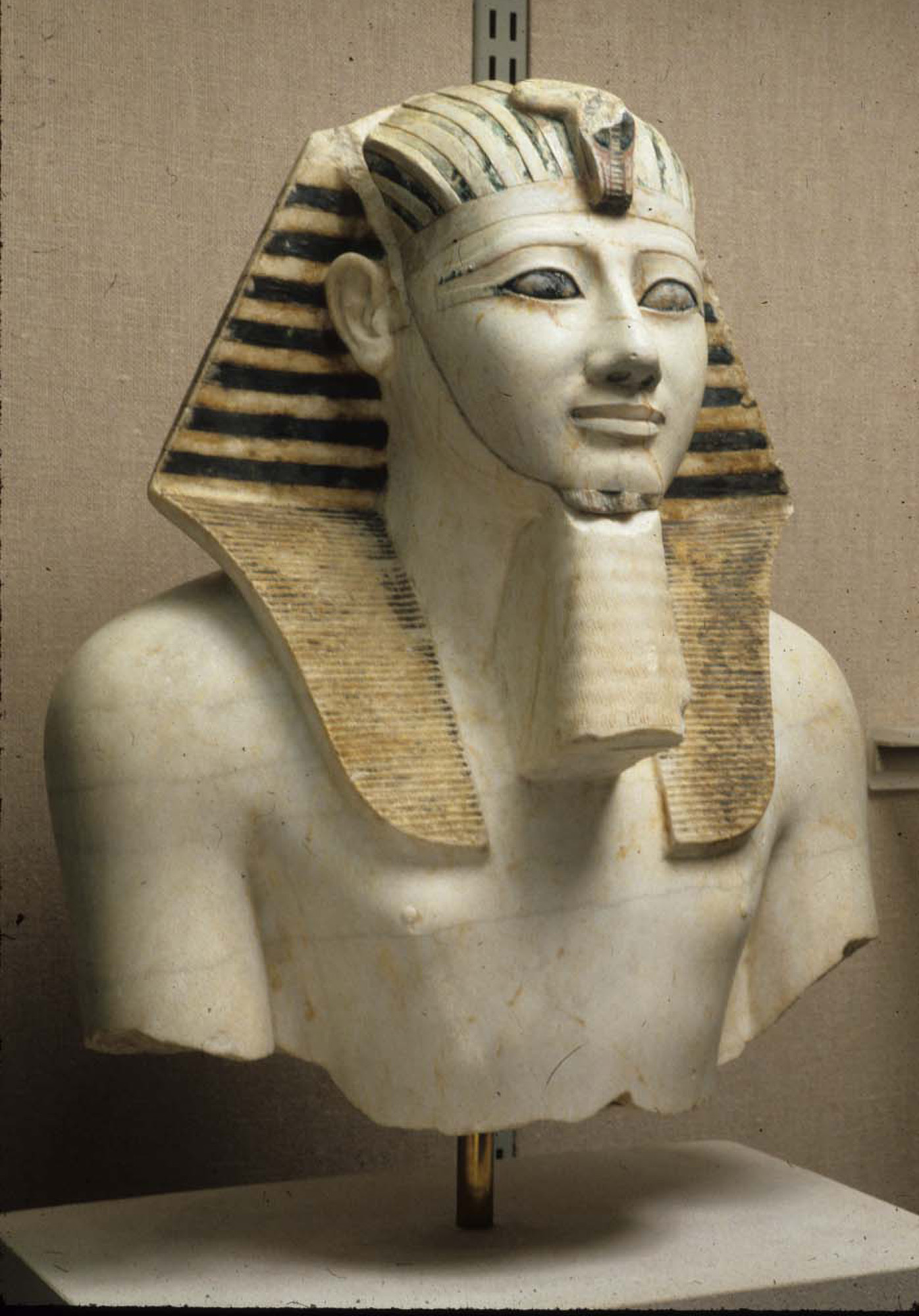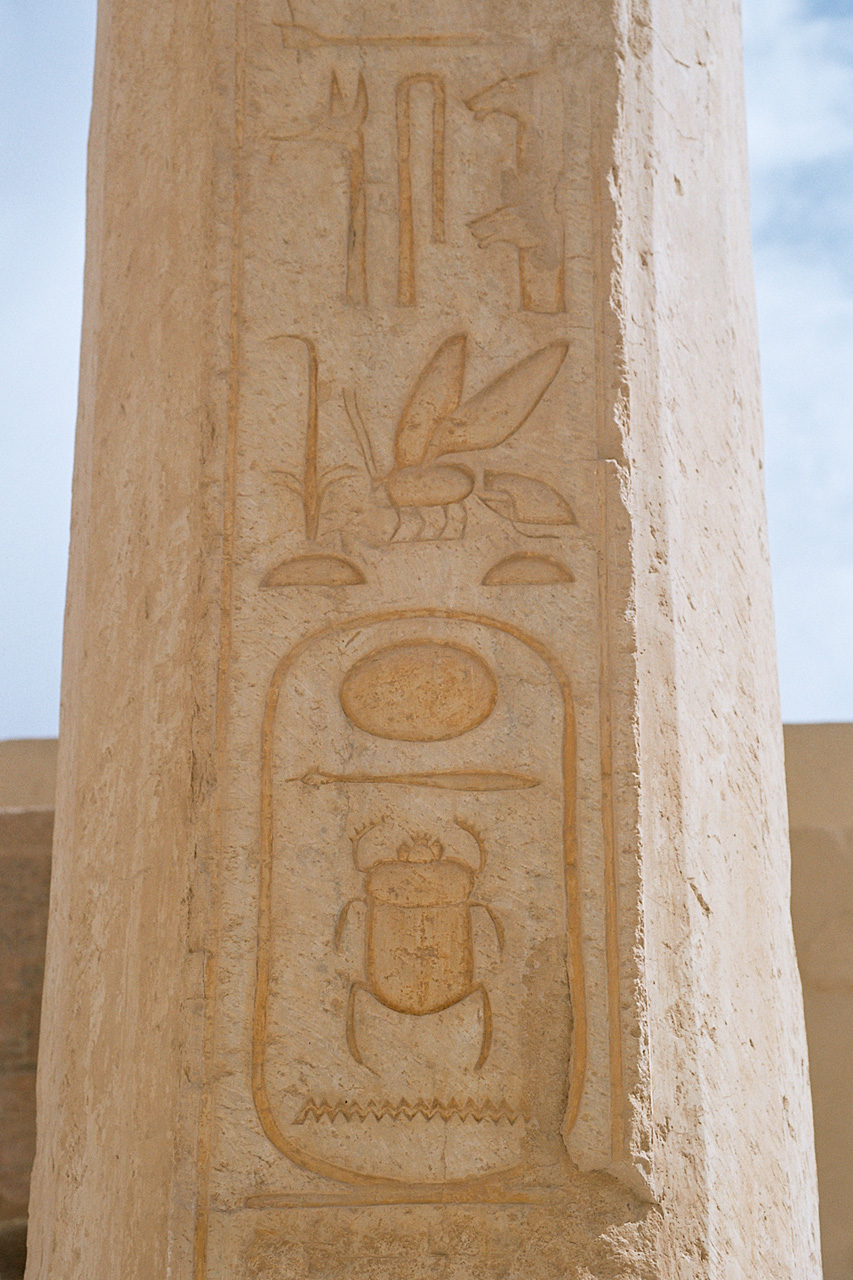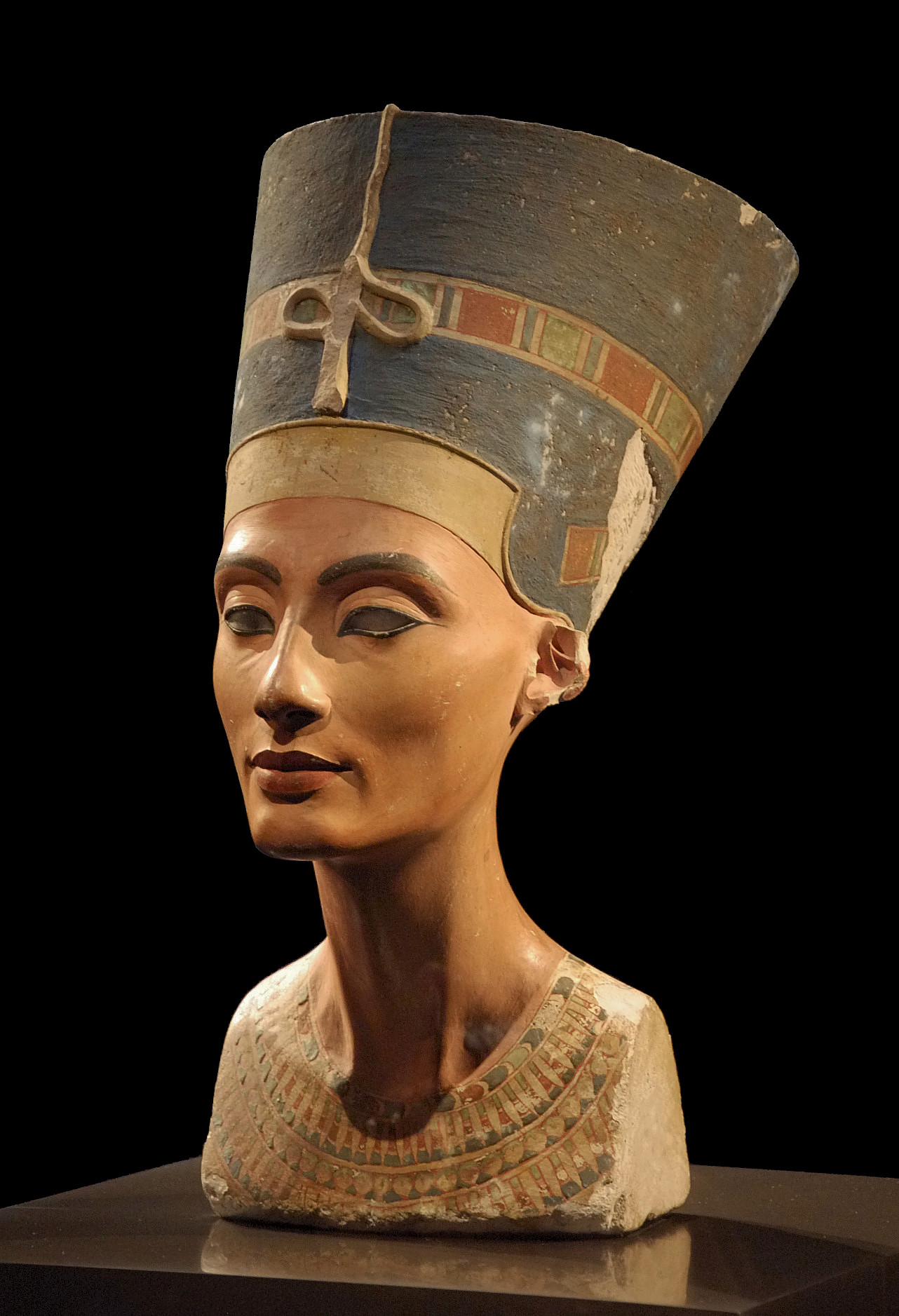|
Thutmose
Thutmose (also rendered Thutmoses, Thutmosis, Tuthmose, Tutmosis, Thothmes, Tuthmosis, Thutmes, Djhutmose, Djehutymes, etc.) is an Anglicization of the Ancient Egyptian personal name ''dhwty-ms'', usually translated as "Born of the god Thoth". Thoutmôsis (in Ancient Greek Θούθμωσις / Thoúthmôsis ) is the Hellenized form of the Egyptian Ḏḥwtj-mś (reconstructed pronunciation: /tʼaˈħawtij ˈmissaw/) and means "Born of Thoth ". This theophoric name was part of the royal titulary of four pharaohs of the 18th dynasty as the name of Sa-Rê or “birth name”. It was also worn by the eldest son of Amenhotep III, high priest of Ptah, as well as by a vizier who exercised his functions successively under Thutmose IV and Amenhotep III. Under this last king and under his successor, Amenhotep IV, two other high dignitaries, royal sons of Kush, similarly called themselves "Born of Thoth" Ancient Egyptians Monarchs and royals The name was common among royals of the Eightee ... [...More Info...] [...Related Items...] OR: [Wikipedia] [Google] [Baidu] |
Thutmose III
Thutmose III (variously also spelt Tuthmosis or Thothmes), sometimes called Thutmose the Great, was the sixth pharaoh of the Eighteenth Dynasty. Officially, Thutmose III ruled Egypt for almost 54 years and his reign is usually dated from 28 April 1479 BC to 11 March 1425 BC, from the age of two and until his death at age fifty-six; however, during the first 22 years of his reign, he was coregent with his stepmother and aunt, Hatshepsut, who was named the pharaoh. While he was shown first on surviving monuments, both were assigned the usual royal names and insignia and neither is given any obvious seniority over the other. Thutmose served as the head of Hatshepsut's armies. During the final two years of his reign, he appointed his son and successor, Amenhotep II, as his junior co-regent. His firstborn son and heir to the throne, Amenemhat, predeceased Thutmose III. He would become one of the most powerful pharaohs of the 18th dynasty. Becoming the sole ruling pharaoh of the ... [...More Info...] [...Related Items...] OR: [Wikipedia] [Google] [Baidu] |
Thutmose II
Thutmose II (sometimes read as Thutmosis or Tuthmosis II, Thothmes in older history works in Latinized Greek; Ancient Egyptian: /''ḏḥwty.ms''/ ''Djehutymes'', meaning "Thoth is born") was the fourth Pharaoh of the Eighteenth Dynasty of Egypt. His reign is generally dated from 1493 to 1479 BC. His body was found in the Deir el-Bahri Cache above the Mortuary Temple of Hatshepsut and can be viewed today in the National Museum of Egyptian Civilization in Cairo. Family Thutmose II was the son of Thutmose I and a minor wife, Mutnofret. He was, therefore, a lesser son of Thutmose I and chose to marry his fully royal half-sister, Hatshepsut, in order to secure his kingship. While he successfully put down rebellions in Nubia and the Levant and defeated a group of nomadic Bedouins, these campaigns were specifically carried out by the king's Generals, and not by Thutmose II himself. This is often interpreted as evidence that Thutmose II was still a minor at his accession. Thutmose I ... [...More Info...] [...Related Items...] OR: [Wikipedia] [Google] [Baidu] |
Thutmose I
Thutmose I (sometimes read as Thutmosis or Tuthmosis I, Thothmes in older history works in Latinized Greek; Ancient Egyptian: '' ḏḥwtj- ms'', ''Tʼaḥawtī-mīsaw'', , meaning "Thoth is born") was the third pharaoh of the 18th Dynasty of Egypt. He received the throne after the death of the previous king, Amenhotep I. During his reign, he campaigned deep into the Levant and Nubia, pushing the borders of Egypt farther than ever before in each region. He also built many temples in Egypt, and a tomb for himself in the Valley of the Kings; he is the first king confirmed to have done this (though Amenhotep I may have preceded him). Thutmose I's reign is generally dated to 1506–1493 BC, but a minority of scholars—who think that astrological observations used to calculate the timeline of ancient Egyptian records, and thus the reign of Thutmose I, were taken from the city of Memphis rather than from Thebes—would date his reign to 1526–1513 BC. He was succeeded by his son T ... [...More Info...] [...Related Items...] OR: [Wikipedia] [Google] [Baidu] |
Thutmose IV
Thutmose IV (sometimes read as Thutmosis or Tuthmosis IV, Thothmes in older history works in Latinized Greek; egy, ḏḥwti.msi(.w) "Thoth is born") was the 8th Pharaoh of the 18th Dynasty of Egypt, who ruled in approximately the 14th century BC. His prenomen or royal name, Menkheperure, means "Established in forms is Re." He was the son of Amenhotep II and Tiaa. Life Thutmose IV was born to Amenhotep II and Tiaa, but was not actually the crown prince and Amenhotep II's chosen successor to the throne. Some scholars speculate that Thutmose ousted his older brother in order to usurp power and then commissioned the Dream Stele in order to justify his unexpected kingship. Thutmose's most celebrated accomplishment was the restoration of the Great Sphinx of Giza and subsequent commission of the Dream Stele. According to Thutmose's account on the Dream Stele, while the young prince was out on a hunting trip, he stopped to rest under the head of the Sphinx, which was buried up to t ... [...More Info...] [...Related Items...] OR: [Wikipedia] [Google] [Baidu] |
Thutmose (sculptor)
Thutmose, also known as "The King's Favourite and Master of Works, the Sculptor Thutmose" (also spelled Djhutmose, Thutmosis, and Thutmes), was an Ancient Egyptian sculptor. He flourished around 1350 BC, and is thought to have been the official court sculptor of the Egyptian pharaoh Akhenaten in the latter part of his reign. A German archaeological expedition digging in Akhenaten's deserted city of Amarna, Akhetaten, known today as Amarna, found a ruined house and studio complex (labeled P47.1-3) in early December 1912; the building was identified as that of Thutmose based on an ivory Blinkers_(horse_tack), horse blinker found in a rubbish pit in the courtyard inscribed with his name and job title.#Reeves2005, Reeves. (2005) p. 157. Since it gave his occupation as "sculptor" and the building was clearly a sculpture workshop, the determination seemed logical and has proven to be accurate. Recovered works Among many other sculptural items recovered at the same time was the polychro ... [...More Info...] [...Related Items...] OR: [Wikipedia] [Google] [Baidu] |
Thutmose (musician)
Umar Ibrahim (born August 4, 1995), known better by his stage name Thutmose, is a Nigerian-American rapper, singer, and songwriter based in Brooklyn, New York. Early life and education Ibrahim grew up in a small city outside of Lagos, Nigeria. Shortly after the Lagos armoury explosion in 2002, at age 7, Ibrahim and his family moved to New York. Ibrahim went to Alfred State College for a year studying computer science, but dropped out to pursue music full-time. Career Thutmose first gained attention in 2017 after releasing a freestyle to the Kendrick Lamar single " Humble". On October 16, 2017, Thutmose released the single "WuWu" (short for "what's up with you?") through ''Pigeons and Planes''. Speaking about the track, Ibrahim said, "Especially with dark times in the world, I hope this song serves as a reminder that there's still a lot of love in the world." On April 30, 2018, Thutmose released a track titled "Run Wild" featuring NoMBe. Originally intended for an upcoming de ... [...More Info...] [...Related Items...] OR: [Wikipedia] [Google] [Baidu] |
Thutmose (19th-dynasty Vizier)
Thutmose (also rendered Thutmoses, Thutmosis, Tuthmose, Tutmosis, Thothmes, Tuthmosis, Thutmes, Djhutmose, Djehutymes, etc.) is an Anglicization of the Ancient Egyptian personal name ''dhwty-ms'', usually translated as "Born of the god Thoth". Thoutmôsis (in Ancient Greek Θούθμωσις / Thoúthmôsis ) is the Hellenized form of the Egyptian Ḏḥwtj-mś (reconstructed pronunciation: /tʼaˈħawtij ˈmissaw/) and means "Born of Thoth ". This theophoric name was part of the royal titulary of four pharaohs of the 18th dynasty as the name of Sa-Rê or “birth name”. It was also worn by the eldest son of Amenhotep III, high priest of Ptah, as well as by a vizier who exercised his functions successively under Thutmose IV and Amenhotep III. Under this last king and under his successor, Amenhotep IV, two other high dignitaries, royal sons of Kush, similarly called themselves "Born of Thoth" Ancient Egyptians Monarchs and royals The name was common among royals of the Eightee ... [...More Info...] [...Related Items...] OR: [Wikipedia] [Google] [Baidu] |
Crown Prince Thutmose
Thutmose ( egy, ḏḥwti-msi(.w)) was the eldest son of Pharaoh Amenhotep III and Queen Tiye, who lived during the Eighteenth Dynasty of Egypt. His early death led to the reign of Akhenaten, his younger brother—as the successor to the Egyptian throne—and the intrigues of the century leading up to Ramesses II, the start and ultimately the failure of Atenism, the Amarna letters, and the changing roles of the kingdom's powers. Life Prince Thutmose served as a priest of Ptah in ancient Memphis. His full royal titles were "''Crown Prince'', ''Overseer of the Priests of Upper and Lower Egypt'', ''High Priest of Ptah in Memphis'' and ''Sm-priest'' (of Ptah)." He is known from a relatively small number of objects. A small schist statuette in the Louvre Museum shows the prince as a miller and another small schist statue in Berlin depicts him as a mummy lying on a bier.Aidan Dodson & Dyan Hilton, The Complete Royal Families of Ancient Egypt, Thames & Hudson (2004), p.157 The mill ... [...More Info...] [...Related Items...] OR: [Wikipedia] [Google] [Baidu] |
Thutmose (18th-dynasty Vizier)
Thutmose was an ancient Egyptian vizier under Amenhotep III, during the 18th Dynasty. As vizier of the North (i.e. of Lower Egypt), Thutmose officiated from Memphis, while his southern counterpart was based in Thebes. He was married to Tawy, and had at least two sons: Ptahmose, who became High Priest of Ptah in Memphis, and Meryptah, who later assumed many titles such as prophet and chief steward of the Mortuary Temple of Amenhotep III. Thutmose is depicted along with his son Ptahmose on a false door-shaped stele now in Florence (inv. 2565). He is mentioned also on a broken stele from Memphis, dedicated to his sons; the two portions of this stele are located in the British Museum and in Leiden respectively.Bosse-Griffiths, op. cit., pp. 56ff; pl. XIV. References Bibliography K. Bosse-Griffiths, "The Memphite Stela of Merptaḥ and Ptaḥmosĕ", ''The Journal of Egyptian Archaeology The ''Journal of Egyptian Archaeology (JEA)'' is a bi-annual peer-reviewed ... [...More Info...] [...Related Items...] OR: [Wikipedia] [Google] [Baidu] |
Tuthmose (Viceroy Of Kush)
Tuthmose was the Viceroy of Kush during the reign of Akhenaten. Tuthmose was given the titles ''King's Son of Kush, Overseer of the Gold Lands of Amun, Overseer of masons, Overseer of the borderlands of His Majesty'', and ''Fan-bearer on the King's right''. In year 12 of Akhenaten, Tuthmose was ordered to put down a rebellion by some of the Nubians, according to a stela set up at Buhen Buhen ( grc, Βοὥν ''Bohón'') was an ancient Egyptian settlement situated on the West bank of the Nile below (to the North of) the Second Cataract in what is now Northern State, Sudan. It is now submerged in Lake Nasser, Sudan; as a resu .... Here were found the fragments of the stela mentioning this rebellion and a viceroy of Kush. The latter's name is lost but it seems likely that it was Tuthmose as he is so far the only known viceroy of Kush datable under Akhenaten.H. S. Smith: ''The Fortress of Buhen, The Inscriptions'' (Egypt Exploration Society, Excavation Memoirs 48), London 1976, ... [...More Info...] [...Related Items...] OR: [Wikipedia] [Google] [Baidu] |
Thoth
Thoth (; from grc-koi, Θώθ ''Thṓth'', borrowed from cop, Ⲑⲱⲟⲩⲧ ''Thōout'', Egyptian: ', the reflex of " eis like the Ibis") is an ancient Egyptian deity. In art, he was often depicted as a man with the head of an ibis or a baboon, animals sacred to him. His feminine counterpart was Seshat, and his wife was Ma'at. He was the god of the moon, wisdom, writing, hieroglyphs, science, magic, art, and judgment. His Greek equivalent is Hermes. Thoth's chief temple was located in the city of Hermopolis ( egy, ḫmnw , Egyptological pronunciation: "Khemenu", cop, Ϣⲙⲟⲩⲛ ''Shmun''). Later known as ''el-Ashmunein'' in Egyptian Arabic, the Temple of Thoth was mostly destroyed before the beginning of the Christian era, but its very large pronaos was still standing in 1826. In Hermopolis, Thoth led "the Ogdoad", a pantheon of eight principal deities, and his spouse was Nehmetawy. He also had numerous shrines in other cities. Thoth played many vital and promin ... [...More Info...] [...Related Items...] OR: [Wikipedia] [Google] [Baidu] |





